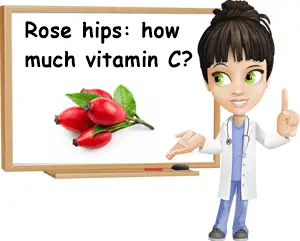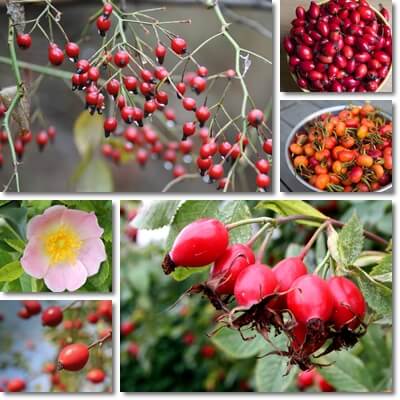They say it’s best to get as much of your vitamins from food. But seeing that studies say you need at least 500 mg of vitamin C a day for optimal health, where can you get that much vitamin C if not from dietary supplements? One cheap, readily available and natural source of vitamin C is rose hip, the fruit of the rose plant. While it’s not a solution for every day, eating fresh or even dried rose hips does get you all of the vitamin C you need, and more, as well as other vitamins, minerals, bioflavonoids and antioxidants.
What are rose hips?
Rose hips, rosehips or hips are the fruit of the rose plant.
The names are used to denominate the fruits of all rose plants, both wild and cultivated roses. But seeing that usually only wild roses produce fruits that are edible, and that you would want to eat, the names rose hips and hips are used to refer to the fruits of wild roses in particular.
Rose hips are in season starting October and are ripe and ready to be harvested once they turn bright red (although some species produce orange, red-purple or dark purple fruits). Ideally, harvest them after the first frosts which should help temper acidity. If it’s a mild winter, some fruits will last on the plant all season, until February even (that is, unless the birds get to them).

How much vitamin C in rose hips?
There’s usually a lot of vitamin C in rose hips. More than in oranges and kiwifruit and other fruits that are generally considered good sources of the nutrient. On average, rose hips provide anywhere between 300 mg and 1300 mg of vitamin C per 100 g serving. To give you a good idea of what these numbers mean, the average adult woman requires a minimum of 75 mg of vitamin C a day for good health, while the average adult man requires a minimum of 90 mg. So rose hips are an overall safe bet when it comes to filling up on vitamin C.
But studies have found that the vitamin C content in rose hips is highly variable and can range from almost nothing to incredible amounts, rivaling the absolute best natural sources of vitamin C such as the Kakadu plum/salty plum/green plum/billygoat plum, the camu camu or the acerola cherry. Here are some numbers to put things into perspective:
- Rose hips: 300 – 1300 mg of vitamin C/100 g (average content) and 2000+ mg of vitamin C/100 g (record content)
- Kakadu plum: 2300 – 3100 mg of vitamin C/100 g (average content) and 5300 mg of vitamin C/100 g (record content)
- Camu camu: 1880 – 2280 mg of vitamin C/100 g (average content) and up to 3000 mg or 3 g of vitamin C/100 g (record content)
- Acerola: 1677 mg of vitamin C/100 g (average content) and up to 4.6 g of vitamin C/100 g (record content)
- Oranges (all varieties average): 45-70 mg of vitamin C/100 g
- Strawberries: 58 mg of vitamin C/100 g
- Bell peppers: 80.4 mg (green), 127.7 mg (red), 183.5 mg (yellow) vitamin C/100 g
- Kiwifruit (green): 92.7 mg of vitamin C/100 g
- Kiwifruit, ZESPRI SunGold (yellow): 161.3 mg of vitamin C/100 g

Reasons for different vitamin C content
What causes the variation in vitamin C content in rose hips? Here is what research has to say:
- Age of the fruit: half-ripe and fully ripe rose hips are highest in vitamin C, whereas unripe or overripe hips are lowest.
- Preparation or processing undergone: fresh hips are highest in vitamin C, whereas cooked fruits have little to no vitamin C. On average, cooking heat destroy anywhere from 10% to 60% of vitamin C in food, depending on the length of cooking time. The longer the cooking time, the higher the vitamin C loss. Dried rose hips also lose vitamin C with time.
- Origin: wild-sourced rose hips have more vitamin C than commercially cultivated ones. For example, the USDA (United States Department of Agriculture) says that wild-sourced rose hips from the Northern Plains Indians provide 426 mg of vitamin C per 100 g.
- Rosa species: some studies list Rosa canina as being lower in vitamin C than other species, but other factors should also be taken into account.
- Altitude: studies say fruits collected from rose hip plants at higher altitudes have been shown to have more vitamin C compared to fruits collected from plants found at lower altitudes.
Sourced studies:
- Fast and Selective Assay of l-Ascorbic Acid in Rose Hips by RP-HPLC Coupled with Electrochemical and/or Spectrophotometric Detection. Ziegler SJ, Meier B, Sticher O. Pharmazeutisches Institut, Eidgenössische Technische Hochschule CH-8092 Zürich, Switzerland.
- Ascorbic Acid Content of Rose Hip Fruit Depending on Altitude. Lăcrămioara OPRICA, Cristina BUCSA, and Maria Magdalena ZAMFIRACHE. Iran J Public Health. 2015 Jan; 44(1): 138–139.
- USDA: U.S. DEPARTMENT OF AGRICULTURE: Rose Hips, wild (Northern Plains Indians) https://fdc.nal.usda.gov/
In general, rose hips are a great source of vitamin C and can successfully supplement any diet that is either lacking in the vitamin or needing a higher intake. They’re also an excellent source of dietary fiber, low in sugar and exceptionally low in salt (sodium), and a more than good source of vitamin A, vitamin B3, B5, vitamin E, vitamin K, calcium, copper, magnesium, manganese and potassium.
In addition to vitamin C and other essential nutrients, they are a good source of bioflavonoids, carotenoids and other antioxidants which further good health.
They are good for the heart and the entire cardiovascular system, metabolism, skin, eyes, teeth and gums and the immune system. See all the wonderful benefits of rose hips and learn some awesome tips to help you get the best of what these winter fruits have to offer in terms of health benefits.
Conclusion
Studies show taking a minimum of 500 mg of vitamin C daily is the threshold for visible therapeutic effects such as a boost in immunity, reduced duration of common cold and flu symptoms, better teeth and gum health, reduced joint inflammation and pain in rheumatoid arthritis and osteoarthritis and subsequent reduced use of anti-inflammatory medication predisposing to stomach ulcers, lower cholesterol levels and overall improved cardiovascular health. In exceptional cases, rose hips are said to have up to 2000 mg of vitamin C per 100 g. Even when the case is not exceptional, they still boast a vitamin C content that is superior to all readily available food sources, not to mention they’re a cheap source of the vitamin (you can literally get them for free, from a bush). Which are two good enough reasons to consider them for when you’re looking to up you intake of vitamin C.
